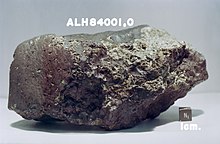ALH 84001 (meteorite)


ALH 84001 (official name Allan Hills 84001 ) is a 1.94 kg heavy meteorite that was found on December 27, 1984 in the Allan Hills ice field ( Victoria Land ) in Antarctica and identified in 1993 as an SNC meteorite ( Martian meteorite ).
description
It consists mainly of coarse-grained cataclastic orthopyroxenite and therefore defines a new subgroup of SNC meteorites, which is referred to as SNC orthopyroxenite. Compared to other Martian meteorites, which mostly have a relatively young geological age, ALH 84001 is already very old. Its age was determined by the Lutetium - Hafnium dating to 4.091 billion years. According to the measurement of the radiation age , ALH 84001 was ejected from the Martian surface about 15 million years ago , presumably by the impact of an asteroid on Mars , and landed on Earth about 13,000 years ago .
In 1996, David S. McKay and his colleagues found structures in the Martian meteorite ALH 84001, which they interpreted as traces of fossil bacteria. Your arguments for traces of fossil life in ALH 84001 are:
- Structures in electron microscope images that are interpreted as fossilized bacteria. It is objected, however, that these structures could also be artifacts of the recording technology used. In addition, the size of the structures is only in the range of a few nanometers; they are thus much smaller than in common terrestrial bacteria. It is true that " nanobacteria " were also supposedly discovered on earth; so far, however, this finding is still controversial.
- Carbonate inclusions , which contain magnetite in a modification that is produced by bacteria on earth. So far, however, it cannot be ruled out that this magnetite can also be produced by non-biological processes.
- Polycyclic aromatic hydrocarbons (PAH, of Engl. P olycyclic A romatic H ydrocarbons) within the carbonates, which can result in the decomposition of bacteria. Again, it is difficult to show that there are no non-biological processes that produce the same pattern of PAHs as found in ALH 84001.
The theses of McKay and his co-authors are still controversial today. [Status?] In the meantime , possible relics from earlier life have also been found in two other Martian meteorites, Shergotty and Nakhla . The theory of panspermia , according to which life on earth was created by germs from space, is based on these structures, among other things .
Trivia
In his thriller Meteor, Dan Brown deals with a meteorite allegedly discovered by NASA with inclusions of extraterrestrial life. The meteor also bears the name ALH 84001.
The pop band Convertible released an album in 2010 called ALH 84001 .
See also
literature
- DS McKay, EK Gibson, KL Thomas-Keprta, H. Vali, CS Romanek, SJ Clemett, XDF Chillier, CR Maechling, RN Zare: Search for past life on Mars: Possible relic biogenic activity in martian meteorite ALH 84001. In: Science , Vol. 273 (1996), pp. 924-930, PMID 8688069
- Alfonso F. Davila et al .: The ALH84001 Case for Life on Mars. In: Joseph Seckbach, et al .: From fossils to astrobiology -records of life on Earth and the search for extraterrestrial biosignatures. Springer, London 2009, ISBN 978-1-4020-8836-0 .
Web links
- The ALH 84001 Meteorite (English)
- Where the cradle of Martian bacteria is. On: Wissenschaft.de from September 20, 2005. Researchers discover the birthplace of the meteorite with the potential traces of life.
- Speech by US President Bill Clinton (English)
- Did myriads of microbes live on Mars? On: heise.de from August 22, 2002.
Individual evidence
- ↑ TJ Lapen, M. Righter, AD Brandon, V. Debaille, BL Beard, JT Shafer, AH Peslier: A Younger Age for ALH84001 and Its Geochemical Link to shergottites Sources in Mars. In: Science. 328, 2010, pp. 347-351, doi: 10.1126 / science.1185395 .
- ↑ DS McKay, EK Gibson, KL Thomas-Keprta, H. Vali, CS Romanek, SJ Clemett, XDF Chillier, CR Maechling, RN Zare: Search for past life on Mars: Possible relic biogenic activity in martian meteorite ALH 84001. In: Science , Vol. 273 (1996), pp. 924-930, PMID 8688069